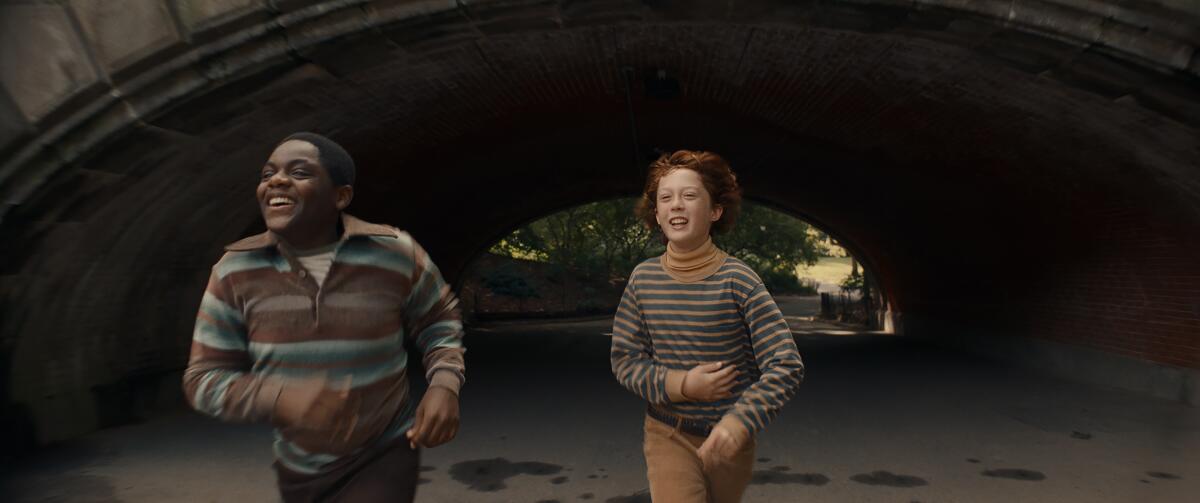Why James Gray wanted to shoot his childhood memories ‘like it’s a ghost story’

Director James Gray’s most recent films have taken viewers into the Amazon (“The Lost City of Z”) and across the solar system (“Ad Astra”). With the 1980-set family drama “Armageddon Time,” Gray moves the action back not just to his native Flushing, Queens, but within spitting distance of the house where he grew up.
“We didn’t shoot in my old house because the woman wouldn’t let us,” Gray says, “but we just moved 90 feet south. I’m not exaggerating.”
Speaking via Zoom from his Los Angeles home, framed by a vintage poster of Luchino Visconti’s “The Leopard,” the 53-year-old filmmaker says that he was obsessed with the re-creation of childhood detail.
“The environment had to be as close to my memory as I could make it. So we got the same plates that we had as a kid, with a green floral pattern. And the chandelier was the same as the one in my dining room. The wallpaper is very, very close.”
But the purpose wasn’t a documentary verisimilitude. Instead, Gray says, he told cinematographer Darius Khondji to “shoot this like it’s a ghost story.”
As a result, in “Armageddon Time,” the actors are almost never filmed in their key light. As Gray says: “In the house, the light will come in from the other room, or there’ll be a lamp, but the actors are a little bit away from the lamp. The whole point is that these people are only temporary inhabitants in a very real physical space.”

The autobiographical coming-of-age story follows a precocious, unruly sixth-grader named Paul (Banks Repeta), who bonds with a similarly willful orphaned Black classmate named Johnny (Jaylin Webb). When the two friends get into trouble, Paul is sent to a ritzy private school, where a major benefactor is the father of the future President Trump, while Johnny is left to his own devices.
In Gray’s dramatization of his own middle-class, secular Jewish family, we bear witness to the complexities of assimilation — this is a liberal-minded family that sneers when President Reagan appears on TV, but is also given to displays of casual prejudice.
The rich supporting cast that rounds out Paul’s family includes Anne Hathaway and Jeremy Strong as his mother and father, and Anthony Hopkins as his beloved grandfather.
Paul’s home is a zone of relative comfort, but its inhabitants are riven by class-consciousness. “It’s a semi-attached row house in Queens, and [the father] drives a Plymouth station wagon. They’re not poor, but they’re looking at [other] big houses with tremendous envy. In my neighborhood, if somebody drove a Cadillac, the whole block started to quiver.”
Gray has a deep empathy for his parents’ compromises, even when they led to violence and exclusion. “I don’t resent my parents,” he says. “They did the best they could. There was probably a side to them that didn’t fill me up with the moral and ethical foundation that is probably needed in the world. And they lashed out in ways that expressed their ineptitude in handling a child who was trying to break on through to the other side. So, there are no easy answers about it.”
Gray’s reflection on his parents’ tough choices extends, in “Armageddon Time,” to a thoroughgoing critique of American capitalism, with guest appearances by both Reagan and members of the Trump family. In Gray’s opinion, “something ended in 1980,” and we’re still feeling the reverberations of that paradigm shift today.
“In American life, the metric is sort of broken,” Gray says. “Integrity cannot yet be monetized by the system, and there’s no way to understand a person with an ethical foundation in anything other than capitalist terms. It doesn’t mean anything to live an ethical life in the United States right now.”
Though Gray demurs from the “classicist” tag that has been attached to his filmmaking, “Armageddon Time” is a familiar-seeming story, but its telling is marked by emotional complexity and richness of detail.
“I have a great love for narrative, clearly told, because I feel that that is where ambiguity can actually really emerge,” Gray says. “That you make something with such clarity that it can’t be vague, and yet it can still have multiple meanings. To me that’s the richest place to play.”
In “Armageddon Time,” Gray courts ambiguity by limiting the story to Paul’s perspective. In the film, a somewhat selfish kid is able to widen his aperture of empathy, but only so far. Though Johnny is a three-dimensional character, the film does not incorporate his point of view.
Gray frames this choice as a deliberate limitation. “You actually want a limited point of view,” he says, “because that’s the way that we can understand the way another person might see the world, which leads to a greater compassion. If I had tried to include Johnny’s point of view, it would’ve been an asinine act of hubris on my part.
“You cannot make a work about everybody and everything all the time, and you shouldn’t,” he continues. “The point of art is the extension of our sympathies … that we look into another consciousness. That is what makes it beautiful. That is why we do it.”
More to Read
From the Oscars to the Emmys.
Get the Envelope newsletter for exclusive awards season coverage, behind-the-scenes stories from the Envelope podcast and columnist Glenn Whipp’s must-read analysis.
You may occasionally receive promotional content from the Los Angeles Times.







